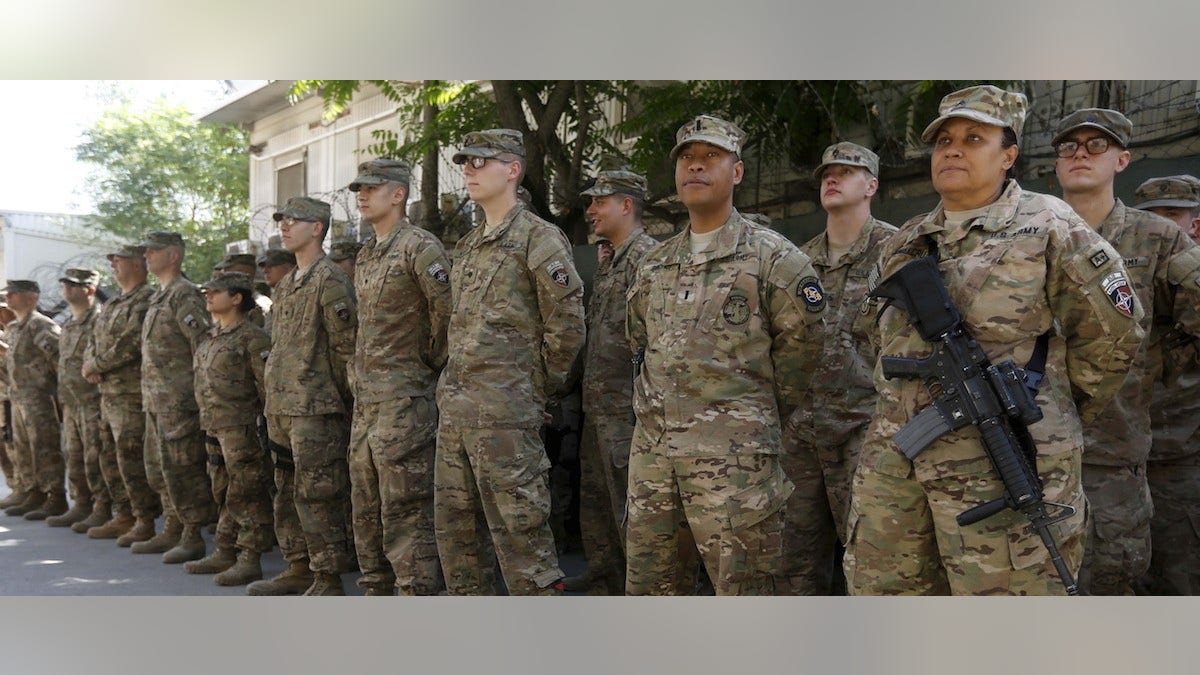
U.S. troops attend a ceremony to commemorate Memorial Day in Kabul, May 25, 2015. Memorial Day is observed annually in the U.S. on the last Monday of May to honor the nation's fallen members of the military. (REUTERS/Omar Sobhani)
As we head towards this year’s elections, one of the main questions that the next President will face is how to eliminate terrorist safe havens without getting bogged down in costly quagmires.
The good news is that after 15 years of struggling with this challenge, in the fight against ISIS we are seeing the beginnings of what can be a sustainable long-term strategy that the United States and its partners can apply across the globe for years to come in Afghanistan, Pakistan, Iraq, Syria, Yemen, Libya, Somalia and other potential hotspots.
In the early years after 9/11, the Bush Administration adopted a large-footprint approach of occupying ungoverned spaces in Afghanistan and Iraq. U.S. troops directly took over security for these areas while building local forces. It proved too costly in lives and dollars and politically unsustainable with the American public.
The early Obama Administration over-corrected, trying a zero-footprint approach in Iraq, Syria, and Libya. This didn’t work either. Drone strikes from afar can disrupt terrorists, but cannot build the enduring security structures needed to eliminate terrorist safe havens. Extremists thrived in Libya and Syria, and spread terrorism and instability to neighboring countries and Europe.
Over the past two years, we have seen a new model begin to take form as the United States has moved to a partner-first approach. Small numbers of U.S. military personnel are on the ground in Iraq, Afghanistan, and Syria in a supporting role, enabling partners to bear the brunt of the fighting. U.S. troops playing the role of advisors are often in harm’s way in these conflicts close to or on the front lines. But the U.S. military is no longer in the business of policing the streets of a foreign city.
The problem with sending U.S. troops in to provide security is that they need to have a partner to transition responsibility to. Too often in Iraq and Afghanistan, our partners weren’t ready to pick up the slack, and we were stuck holding onto territory for years. But a small numbers of American advisors can be a tremendous force multiplier, giving local forces confidence in the fight and restraining bad behavior such as sectarian killings that feed these conflicts.
This approach requires patience. In some cases, it may mean moving more slowly, waiting until partners are ready, as we have seen in the campaign in Iraq to liberate Mosul. In others it may take years for indigenous forces to cohere into an effective fighting force such as in southwest Syria where an American-supported coalition of local groups took years to build.
There will remain a role for direct U.S. action in the form of air strikes to support these partners and special operations raids to take out high value terrorist targets. These measures, while necessary, can only be considered a stop-gap, though, until sustainable security structures are built to close ungoverned spaces.
This approach must also be accompanied by engagement with key regional states. Outside actors can often exacerbate conflicts in ungoverned spaces by arming extremist groups as their proxies on the ground and failing to secure borders that become key supply routes, as is the case in Syria and Afghanistan.
The United States must leverage its involvement to drive neighboring countries to work towards common solutions or at least refrain from making things worse . At the same time, the U.S. must be mindful that it is unlikely to convince others to give up their core interests.
When the United States over-invests, as it did during the Bush years, friendly partners will often free ride while adversaries use a large U.S. troop presence as targets for attack. When we disengage entirely, as in northwestern Syria today, other actors step into the fold, fueling the fire. When the United States engages but does not overcommit, as it is doing in ISIS-held western Iraq and eastern Syria today, it is possible to coordinate the necessary international support.
Finally, the United States must help local actors resolve long-standing political conflicts, improve governance, and give disenfranchised populations a voice. The Taliban rose to power in Afghanistan because of the rampant warlordism that followed the Soviet Union’s withdrawal. ISIS swept virtually unopposed into Iraqi Sunni territory in 2014 because the Shia-dominated government in Baghdad had marginalized Iraq’s Sunnis.
There are no easy fixes to these underlying political problems, but effective and sustainable local security provided by non-extremist forces acceptable to the population is the key first step that leads to better governance. Improved security should be married with international support for local governing structures that provide basic services to the population.
Today, the United States may finally be finding an approach to eliminating terrorist safe havens that is sustainable over the long haul. Supporting partners on the ground, deploying limited but necessary military power, coordinating the international response, and building local governance structures is the formula for achieving this objective. It will be up to the next President to take this approach, apply it across the globe, and explain it to the American people.
